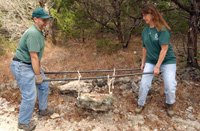
In July 2008, eleven Trail Tamers joined about thirty volunteers from the Continental Divide Trail Alliance to work just below Tin Cup Pass, a few miles south of Buena Vista. Our goal was to replace a steep, eroding section of the CDT by building several switchbacks.
We all gathered in the ghost town of St Elmo (Motto: More chipmunks than people) on July 16. The road up to Tin Cup Pass requires 4-wheel drive, so we made sure everyone and their gear found a ride. At the campsite, we set up our tents, ate lunch, and went for a tour of the work project. CDTA and the Salinas Ranger District were well prepared with tools, and we spent an hour or two at work before walking down for dinner. CDTA provided the kitchen, the food, and a chef.
The next two days began early and ended when the afternoon showers arrived. Actually, we ended a little late on Thursday, resulting in an hour of grumpy, wet, and cold campers, but by dinnertime, we were all better. Another complication was, about two hundred years ago someone planted a few trees right in the middle of our new trails! Vigorous work with a Pulaski took care of the smaller stumps, and CDTA had some experienced people who used chain saws and a cable-grip to pull out the bigger ones.
No work was scheduled on Saturday because that coincided with the annual TrailFest exhibition. The Forest Service and many local and national outfitters had booths set up in McPhelemy Park in Buena Vista, and a dozen guided trips brought visitors out to various destinations along the CDT. After cleaning up, four of us went up to Leadville for dinner at The Grille, a highly recommended destination for any trip to central Colorado.
We completed three switchbacks, each one about fifty yards. A separate project, higher up the trail, was tackled by a Scout group and they completed another fifty yards, including building up a section of trail with logs and many, many buckets of soil. And another group built a plank bridge across an eight-foot wide creek. This task was more than just hard work; it also required a bit of engineering skill to position the bridge high enough to withstand a flood.


